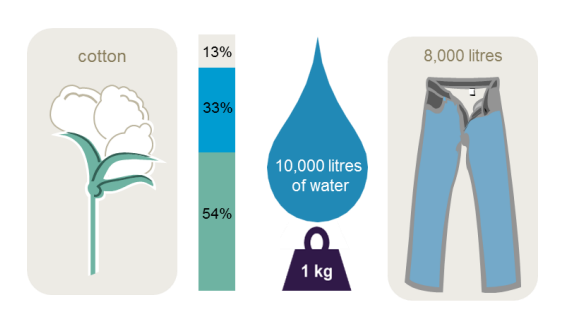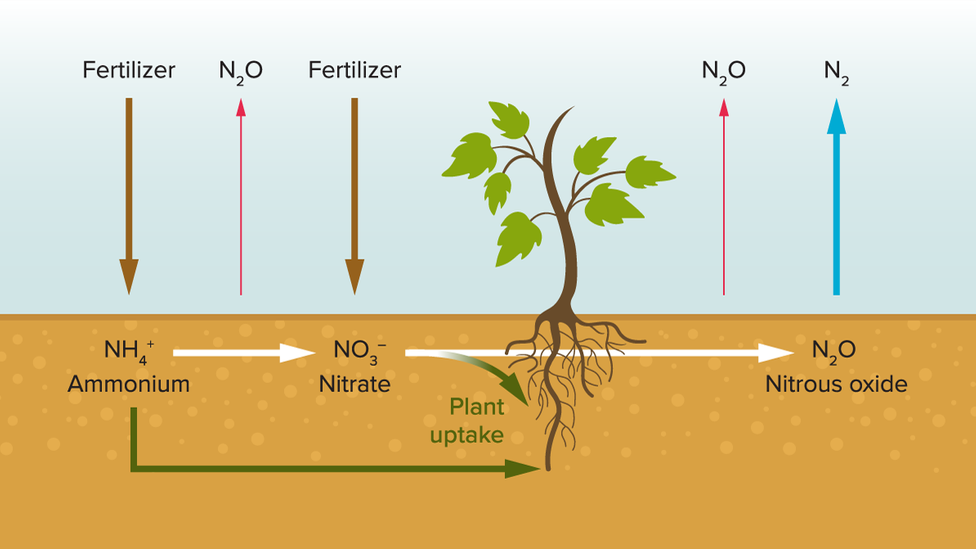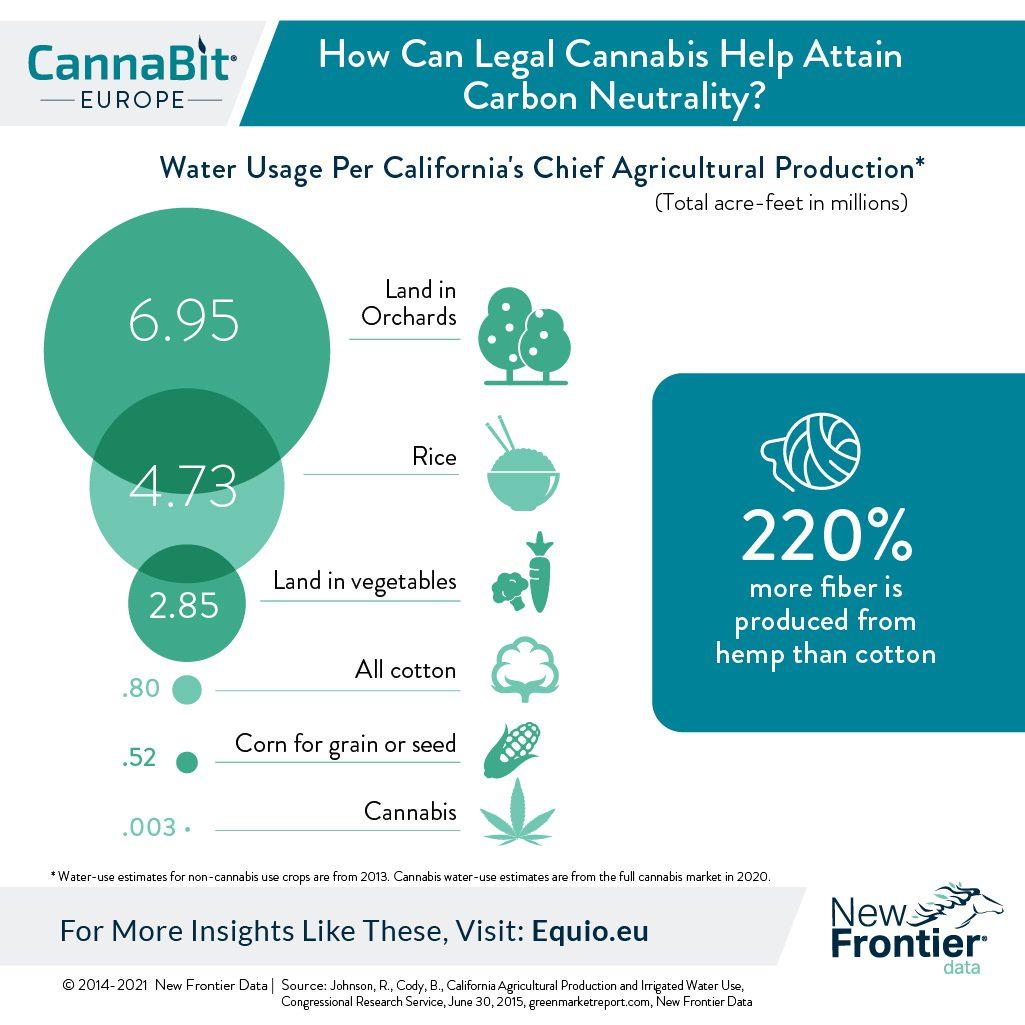Under the microscope: Green Houses Gases of the Cotton Industry
Cotton is killing the climate.
Now, you can say, “but it’s natural, sustainable, reusable, and recyclable.” And we agree. However, did you know?

Source: https://waterfootprint.org/media/cache/cb/1a/cb1adc5838673bc1ce7023a0c60c613a.jpg
Cotton cultivation –
- Uses 16% of the total insecticides used across the world
- Uses around 8.2 million tons of various chemicals
- Causes 220 million tons of CO2 emissions per year
- Contributes to around 233 billion cubic meters of the global water footprint in a year
You would find it hard to believe but all of that comes from the global cultivation of cotton which utilizes only 2.3% of the world’s cultivable land.

source: https://hess.copernicus.org/articles/15/1577/2011/
To put things into perspective, the cotton we use and see in fabrics nowadays is mostly genetically modified (GMP). Moreover, farmers rely on large quantities of fertilizers and pesticides to maintain their yield.
Why Is Organic Cotton Not A Promising Solution To Global Warming?
Now, you may bring up the point of cultivating organic cotton. Yes. It has 40% less global warming potential as compared to genetically modified cotton. Moreover, organic cotton uses 91% less water as compared to genetically modified ones.
However, organic cotton is susceptible to fluctuations in weather, and common pests and has a low tolerance towards dry conditions. Most importantly, they provide lower yields as compared to their genetically modified counterparts. Therefore, it is riskier for farmers to invest in the cultivation of organic cotton.
Even if farmers switched from cultivating genetically modified or hybrid cotton varieties to organic or wild-type cotton, it would not be the answer to climate change concerns.
The processing of natural fiber would still consume enough chemicals and emit greenhouse gases to alter the climate in the next decade.
Therefore, organic or genetically modified, cotton is not the sustainable source of fabric you thought it to be.
Did you know? The textile industry produces over 2 billion tons of carbon dioxide per year. While it depends on the textile, the entire life-cycle of textiles can account for 6.7% of the entire greenhouse gas emission across the globe.
Why Are We Worried About Greenhouse Gas Emissions From The Cotton Industry?
It would not have been a grave concern, except, over the last 5 decades the production of textiles has tripled. For example, in 2018 itself, around 107 million tons of textiles were produced. The EJF predicts that the production will reach 145 million tons by 2030.
Around 43% of greenhouse gas emissions in China come from apparel production and 44% of India’s greenhouse gas emissions come from the cotton industry. However, Europe imports around 87% of its textiles. It contributes to “carbon leakage.”

Currently, cotton farmers use “highly-hazardous pesticides” in large quantities. Global cotton agriculture uses over 8.2 million tons of chemicals that pollute the soil and water and harm biodiversity.
For example, one study shows that cotton is the most preferred fiber (textile) in Australia. However, it has the following impacts on the environment –
| Total Market Share | 53.97% |
| Climate Change Potential (CCP) | 45% |
| Acidification Potential | 96% |
| Water Depletion | 40% |
| Abiotic Resource Depletion Potential | 46% |
| Agricultural land Occupation | 79% |
Cotton apparels enjoy high favour in the clothing market, but they also have a high environmental impact.
Most of the apparel imported by Australia and Europe comes from China, India, Bangladesh, and Indonesia. These four countries rely on fossil fuel (coal and natural gas) powered electricity for the processing of cotton fibres and manufacturing of apparel.
Cotton and Its Relationship with High Levels of Nitrous Oxide in the Atmosphere
Currently, cotton farmers use “highly-hazardous pesticides” in large quantities. Global cotton agriculture uses over 8.2 million tons of chemicals that pollute the soil and water and harm biodiversity. Cotton cultivation requires chemical fertilizers that release substantial quantities of nitrous oxide (N20) into the atmosphere.
Growing cotton profitably without the use of nitrogen-rich fertilizers is next to impossible. Cotton crops require a steady and moderate supply of nitrogen for favourable yields.
Sadly, N20 is one of the biggest culprits in climate change. In the past four decades, the N20 emissions have increased by around 30% and the use of nitrogen-based fertilizers plays a significant role in that elevation.

Source: https://ychef.files.bbci.co.uk/976×549/p09kkbh6.png
A Significant number of studies and published research shows that fertilizer production and use contribute to the highest percentage of N2O production.
N2O is 310-times more powerful as compared to CO2 in contributing to global warming. It is a potent greenhouse gas released by almost all cotton cultivations across the world.
If the consumption rate of nitrogen-based fertilizers doesn’t decrease, we may be looking at an increase of 3 degrees Celsius (5.4-degree Fahrenheit) in the average climate in the next decade.
We need a better alternative to cotton that does not depend on nitrogen for high yield.
How Does The Cotton Industry Impact The Ecosystem Negatively?
Cotton requires strong chemical pesticides and fertilizers to thrive. Farmers often add minerals and fungicides to their crops as well. These mix in the soil and the runoff contains all the harmful chemicals used during the crop growing season.
These hazardous and sometimes toxic chemicals mix with the water from ponds, lakes, and rivers due to rainfall and irrigation practices.

These are agents that affect the biodiversity of the surrounding areas and water bodies by causing direct toxicity. The chemicals from fertilizers and added minerals may also have a long-term effect on the environment via long-term accumulation in the soil.
The weed killers used in the field reduce the biodiversity of the agricultural land as well as the adjacent lands almost immediately.
The cultivation of genetically modified or commercial cotton not only increases the greenhouse gases in the atmosphere but also impacts the ecosystem directly.
While cotton farming is contributing to a significant release of greenhouse gases and a rise in temperature, the resulting change will not be conducive to cotton farming. The sharp rise in temperature and the lack of availability of fresh water for irrigation will soon prove to be major challenges for cotton farmers.
Cotton is extremely sensitive to changes in the climate and soon, keeping a profitable yield will become next to impossible for the cotton farmers and industries manufacturing cotton fabrics. In the next two decades, as much as 40% of all cotton-producing areas will witness shorter growing seasons and smaller yields.
How Is Hemp A Smarter Alternative To Cotton?
So, what do we need right now? We need a source of fabric that –
- Consumes less water
- Uses fewer or almost no harmful fertilizers and pesticides
- Has lower CO2 emissions
Hemp is the right choice when the question of sustainability and climate change arises. Although hemp is not new, the production methods used to make fabric from hemp ensure that our world remains greener for longer. It is the perfect way to reduce greenhouse gas emissions contributing to climate change.
Let’s see how hemp can tackle climate change quickly and naturally.
- It has natural protection from high UV radiation.
- It is more tolerant towards changes in weather as compared to cotton.
- It can “breathe in” a remarkably high level of CO2 as compared to cotton. Thus, directly contributing to the sequestering of greenhouse gases from the atmosphere.
- Growing and processing hemp fibre requires 50% less water as compared to cotton due to higher hemicellulose content.
Hemp cultivation requires around 77.63% fewer seeds, fertilization, field operation, and irrigation costs as compared to cotton.

At the same time, hemp produces more than 200% the fibre as compared to cotton on the same area of land.
How Can Hemp Save The World?
Carbon dioxide is one of the major players in global warming. It is one of the most common greenhouse gases that is contributing to climate change. And hemp is particularly capable of sequestering CO2 from the atmosphere.

Source: https://newfrontierdata.com/wp-content/uploads/2020/12/Screen-Shot-2020-12-09-at-5.31.20-PM.png
According to an article from The Huffington Post, one ton of hemp can trap up to 1.63 tons of carbon dioxide. It utilizes carbon dioxide more efficiently as compared to cotton to create “food” for itself.
In addition to absorbing carbon dioxide more efficiently, hemp processing requires less fossil fuel. Hemp fibre manufacturing units have lower carbon footprints as compared to cotton processing and fibre manufacturing units.
Can Hemp Undo All The Harm Done By Cotton In The Past?
Hemp provides hope for future generations. Hemp is actively providing eco-friendly solutions to fibre and textile manufacturers. It is a natural way to reduce the carbon footprint of the textile industry without compromising the livelihood of the farmers and small entrepreneurs already involved in textile manufacturing enterprises.
It is a low-maintenance, high-yield crop that demands minimum from the environment. In return, it absorbs the carbon dioxide from the atmosphere and improves the richness of the soil for the next round of cultivation. It does not require harsh chemical fertilizers for healthy and profitable growth. Most importantly, hemp needs 50% less water as compared to cotton for the same area.
It is a fast-growing crop, and it’s quite resistant to changes in the climate. It is far more resilient than cotton. Therefore, it promises better yield within a shorter duration.
Sources
https://waterfootprint.org/en/about-us/news/news/world-water-day-cost-cotton-water-challenged-india/
https://www.bbc.com/future/article/20210603-nitrous-oxide-the-worlds-forgotten-greenhouse-gas
https://www.sciencedirect.com/science/article/pii/S240584402200041X
https://ejfoundation.org/news-media/clothes-and-climate-is-cotton-best
https://www.mdpi.com/2073-4395/9/6/271/htm https://www.cambridge.org/core/journals/journal-of-agricultural-science/article/abs/an-assessment-of-greenhouse-gas-emissions-implications-for-the-australian-cotton-industry/2397EDF63D9334450ED9856B424B4042